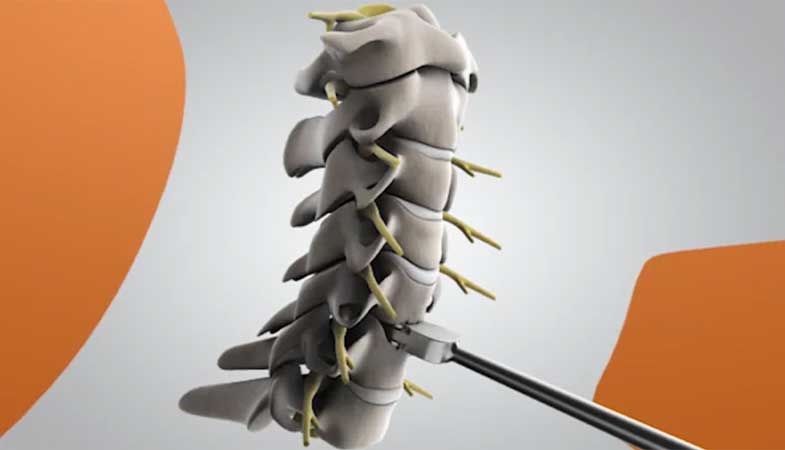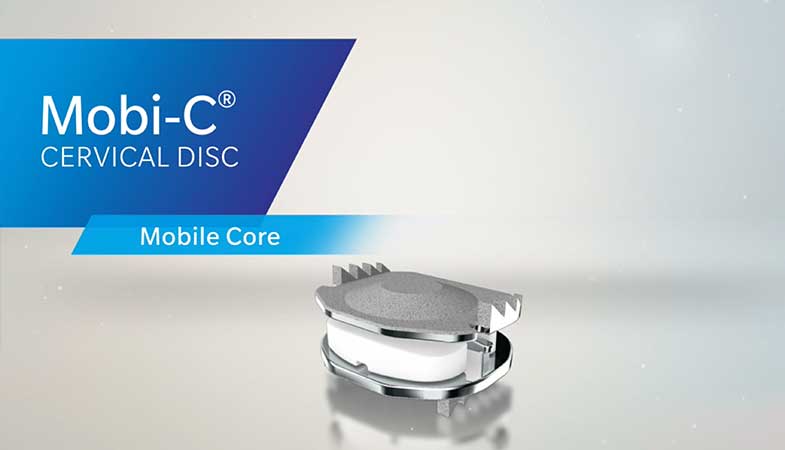
Cervical Spine
(Neck)
Anterior Cervical Decompression, Fusion & Instrumentation (ACDF) is a surgical procedure that aims to alleviate symptoms caused by a herniated or degenerated disc in the neck. This is achieved by removing the affected disc through an anterior approach, typically made in a skin crease, to achieve an optimal cosmetic result. The space vacated by the removed disc is then filled with a spacer to promote fusion between adjacent bones. In some cases, a plate may also be placed to provide additional stability.
Cervical Disc replacement is a surgical procedure in which a damaged or unhealthy disc in the neck is removed and replaced with an artificial disc such as Mobi-C or M6-C. This type of surgery, also known as arthroplasty, aims to preserve the natural motion of the cervical spine instead of fusing the adjacent vertebrae together. By replacing the damaged disc with an artificial one, patients can regain mobility and alleviate pain caused by the disc degeneration.
When abnormal disc material (herniation) or overgrown or arthritic bone causes pressure in the vertebral canal, it can result in pain, weakness, or numbness. In such situations, surgical intervention may be necessary to remove the material that is pressing on the nerve root or spinal cord. Minimally Invasive Microdiscectomy, Laminotomy & Foraminotomy surgery is a procedure that can effectively relieve the pressure and alleviate the symptoms caused by it.
Posterior Cervical Decompression, Fusion & Instrumentation (PCDFI) is a technique that allows for decompression of multiple segments of the cervical spine in patients with multi-level stenosis or deformity of the spine. It also involves placement of screws, connected by rods to afford immediate stability of the cervical spine.
Deformity or Kyphosis is a medical condition characterized by an abnormal curvature of the spine, which can lead to various symptoms such as neck pain, stiffness, and difficulty in maintaining a horizontal gaze. Fortunately, many people can find relief from their symptoms and improve their overall quality of life through deformity correction. The correction process involves various treatments that aim to restore the natural curvature of the spine, resulting in improved posture and reduced pain.
M6-C
The M6 artificial cervical disc offers an innovative option for artificial cervical disc replacement because of its unique design which is based on a natural disc’s qualities.
Engineered to replicate your own disc, the M6 is the only artificial disc that incorporates an artificial nucleus (made from polycarbonate urethane) and a woven fiber annulus (made from polyethylene). The M6 artificial nucleus and annulus are designed to provide the same motion characteristics of a natural disc.
During the M6-C disc replacement surgery, a small 3-to-4 centimeter incision is made in the front of your neck to access your cervical spine. The damaged disc is removed (discectomy), and the impinged nerve is then relieved (decompression). The M6 cervical disc is then inserted into the disc space using specialized and precise instruments. After the M6 is successfully placed, the incision is closed.
After surgery, our doctors will give you guidelines for activities and follow up requirements before you leave the hospital. You may undergo therapy to help heal and strengthen your cervical spine. Follow-up examinations are performed after surgery with your physician to assess your recovery.
Mobi-C
The Mobi-C Cervical Disc is designed for the replacement of cervical discs in the spine in order to restore segmental motion and disc height in adult patients.
In a surgery with the Mobi-C Cervical Disc, the unhealthy disc is removed, but instead of a bone spacer or plastic implant along with a plate and screws, a Mobi-C is implanted into the disc space. Where a fusion procedure is intended to eliminate motion at the surgery levels, the goal of a surgery with Mobi-C is to allow motion at those levels.
The technology is intended for use by adults who are skeletally mature and who experience arm pain and/or neurological symptoms – such as weakness or numbness – with or without neck pain at one or two adjacent levels from C3 – C7 in the cervical spine.
Following the insertion procedure, the Mobi-C artificial disc encourages height restoration and a return to physiological mobility of the spinal segment. The unique design of the device allows for the facilitation of both independent and coupled motions that are similar to natural cervical spine motion, and placement requires no invasive keels or screws.









